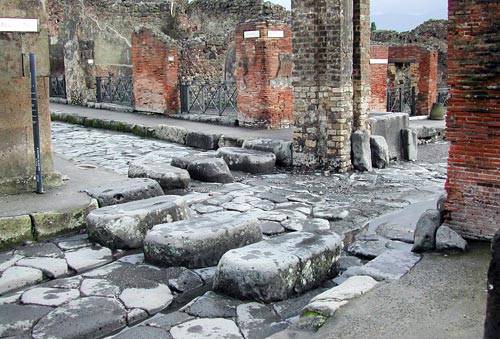The “zebra” pedestrian crossing with its rectangular stripes is all too familiar. According to Wikipedia, it was introduced after WW2; but its roots appear much earlier in history…
During our recent tour of Pompeii I saw how the Romans approached the matter, which they did with their usual pragmatic attitude. Pompeii’s streets are paved with large black flagstones, and are flanked by tall sidewalks. And at frequent intervals these are connected by pedestrian crossings like these:

The similarity to our present day zebra crossing is striking, except that these stripes are as tall as the sidewalk and act as stepping stones. The reason is obvious: when the city was alive – before Vesuvius wiped it out with a belch – the streets must’ve been at various times packed with water, mud, trash and worse. The refined ladies who lived in the exquisite villas we see in ruin today were no doubt eager to keep their dainty sandals and flowing robes above street level as they went about their shopping.
And they had these crossings all over the town – from single-stone versions in smaller alleys to multiple crossings at large intersections, as you see below.


The nearer crossing in the last photo attests to another attribute of this design: note the deep narrow grooves along the road which go through the spaces between the stepping stones. The stones were spaced to the same width as the wheels on a standard cart, allowing wheeled traffic to drive through undisturbed, resulting in the eroded ruts you see in the photo.






That’s fascinating, Nathan. Thanks! Just look at the brickwork!
When I went to Pompeii we were impressed by those exact crossings. It is such a simple solution to several problems, and a reminder how little some things have changed in 2,000 years.